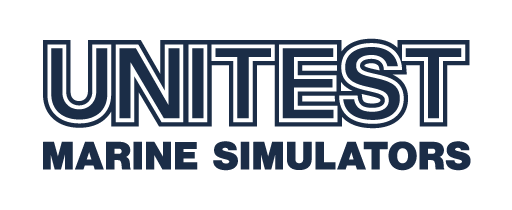
The main purpose of the simulator is the practical preparation of the trainee for engine room operation, and more particularly:
- familiarization with the basic engine room installation (electric power plant system, compressed air system, fresh and sea water cooling system, lubricating and fuel oil system);
- acknowledgment with diesel generators, thrusters and auxiliary equipment starting procedure;
- propulsion system maneuvering;
- power management system operation PMS.
HV-DE3D has been developed to comply with:
- STCW Code: Section A-1/12 and Section B-1/12,
- ISM Code: Section 6 and Section 8.
The simulator is based on an engine room composed on diesel electric propulsion system. The model of the propulsion plant is typical for Platform Supply Vessel. Generally the propulsion system can be described below:
- vessel is to be propelled by two (2) azimuthing thrusters with fixed pitch propellers,
- power to the propellers is to be delivered by four (4) marine, constant speed diesel generators,
- engines and propellers are correctly matched for all operating models, including crash stop,
- propulsion control system is to be arranged so, that control may be safely put from full ahead” to “full astern” and vice versa,
- propulsion control system is to be arranged so, that may be controlled manually or automatically by DP system.
The simulator introduces 3D model of the Engine Room, based on the real equipment. In order to create the impression of working in the real environment, it provides 3D sound which can be listened on 2, 4 or more speakers.
Control room allows remote control of engine room equipment from computers.
Electric Power Plant is equipped with modern Power Management System which enables automatic control of generators according to actual power demand.
HV-DE3D simulator model includes following systems:
- Control Room;
- Diesel Generators;
- Emerg. / Harb. Generator;
- Azimuth Thrusters;
- Bow Thrusters;
- SW Cooling System;
- FW Cooling System;
- FW Aft Cooling System;
- FO system;
- FO Purifier 1;
- FO Purifier 2;
- Lubricating System;
- Compressed Air System;
- Sanitary Water System;
- Sewage Treatment Plant;
- Bilge;
- Water Mist System;
- CO2 System;
- Bridge.
The simulator introduces 3D model of the Engine Room, based on the real equipment.
The 3D model includes very realistic, animated, virtual controls like switches, gauges and lamps. Zoom technique allows navigation in 3D environment and easy access to details.
Here is a list of HV-DE3D main features:
- Highly realistic simulator for ship’s engine room training which can also be used as a low cost introductory simulator.
- The mathematical model simulates a typical ship’s engine room with four 4-stroke, medium speed engines, driving through reduction gears the controllable pitch propellers.
- All vital auxiliary systems have been implemented.
- The user interface includes virtual controls and alarms and creates very realistic environment. The 3D virtual reality with active valves, tank level indicators and selected digital gauges enable comfortable engine room operation and monitoring.
- Multichannel digitized sound provides a very realistic ships’ engine room feel. The sound effects include: engine sound correlated with engine speed, the sound of a diesel generator starting and running, open indicator valve sound, alarm and machine telegraph buzzers.
- Emergency procedure training including fire simulations.
- Operations related to drivers subsystems (electrical supply, hydraulic supply and lubricating oil system) including valves operations and all auxiliary equipment (pumps, coolers, filtration units, etc).
- Drives operations from local control stations.
- Emergency drives operation directly from the hydraulic valves stations:
– Main drives (local rotation of the drive);
– Bow thruster (local pitch control);
– Retractable thruster (local pitch control, local rpm control, local rotation of the drive, local dropdown control). - Switchboard Key Lock System, with possibilities of opening drives panels in Switchboard Room and Aft Drives Room and remove keys to secure drives.
- Drives load characteristics and their influence to power plant system (PMS load).
The main educational tasks which can be accomplished using HV-DE3D have been listed below:
- Learning ship’s engine room typical operating routines.
- Ship’s engine room operation training. The user will have the possibility to accomplish any operational task starting from different setups, both pre-prepared and saved by a user.
- Corrective action learning when faults occur. Different faults can be simulated and mixed in the run-time or loaded from disk.
To meet the requirements:
Engine Room Simulator has been developed to comply with STCW Code:
- Section A-1/12 and Section B-1/12
- ISM Code: Section 6 and Section 8
















